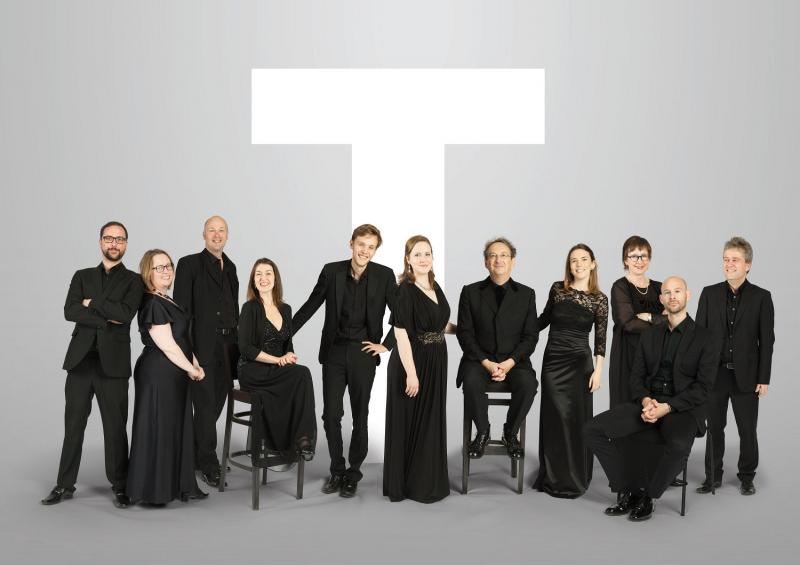The Tallis Scholars, Phillips, Cadogan Hall review - intimacy in late Renaissance music | reviews, news & interviews
The Tallis Scholars, Phillips, Cadogan Hall review - intimacy in late Renaissance music
The Tallis Scholars, Phillips, Cadogan Hall review - intimacy in late Renaissance music
A diverse and vibrant tour of Italian choral music

Peter Phillips and the Tallis Scholars have nothing to prove when it comes to Renaissance choral music – few ensembles can match them for clarity, balance and purity of tone.
The choir is small, just 10 singers, and Cadogan Hall has a dry acoustic, at least compared to the vast basilicas of Northern Italy, so these were intimate readings. The broadly chronological survey began with Palestrina, whose opulent Laudate pueri lacked nothing for the one-to-a-part presentation. A little Palestrina can go a long way, so Phillips (pictured below) was wise to chose two short and distinctive works. The Virgo prudentissima is less dramatic but more terse in its polyphony, and gave the tenors an early challenge with some punishingly high tessitura. Monteverdi rounded out the first half, with his unhelpfully titled Messa a quattro voci da cappella. This is a late work, published in 1650, but harks back to the time of Palestrina and the stile antico, so plenty of rigorous counterpoint and little harmonic movement. But this is still clearly Monteverdi, with operatic melisma freely decorating the counterpoint. Phillips insisted on a clean-cut, stepwise movement for these florid lines, which sometimes felt a little staid, even in a Mass setting.
 The second half opened with a lollipop, Allegri’s Miserere. Some inventive stagecraft elevated this performance, literally, with the cantor positioned on the balcony high above the stage and an antiphonal choir behind the audience. The now-invisible soprano sounded rushed in some of the ornamentation, but was impressively secure for the top Cs.
The second half opened with a lollipop, Allegri’s Miserere. Some inventive stagecraft elevated this performance, literally, with the cantor positioned on the balcony high above the stage and an antiphonal choir behind the audience. The now-invisible soprano sounded rushed in some of the ornamentation, but was impressively secure for the top Cs.
Allegri to Gesualdo could have been a nasty shock, but the O vos omnes provided a gentle transition, with the composer’s wayward harmonies only becoming gradually evident. But there was no mistaking the gloomy mood, with misery piled upon misery across the work’s short span. The second Gesualdo motet, Aestimatus sum, was more radical, lingering for its final lines on the tenor and bass voices, both singing low and in close, often dissonant harmony.
Like Allegri, Antonio Lotti is thought a one-hit wonder, and the programme continued with his hit, the Cruxifixus (a 8). In fact, Lotti wrote many Cruxifixus settings, and for an encore we heard a 10-part version. Both are impressive works, lighter in texture than his Renaissance forebears, but no less sophisticated in his counterpoint. The 10-part setting is particularly elegant and forward-looking for its extensive melodic suspensions.
Three Monteverdi motets closed the programme, Adoramus te, Domine ne in furore and Cantate Domino. Again, the choice of works was ideal, with plenty of variety between each of the short numbers. More significantly, they marked the dawn of a new approach, a lighter and more varied sound from the cusp of the Baroque. Cantate Domino seems too cheerful for a sacred motet, everything about it is smiles and radiance, especially when performed with such vitality and grace. Optimistic music to herald a new departure in the Italian choral tradition, but rounding off this programme it felt more like the end of an era.
rating
Explore topics
Share this article
The future of Arts Journalism
You can stop theartsdesk.com closing!
We urgently need financing to survive. Our fundraising drive has thus far raised £49,000 but we need to reach £100,000 or we will be forced to close. Please contribute here: https://gofund.me/c3f6033d
And if you can forward this information to anyone who might assist, we’d be grateful.

Subscribe to theartsdesk.com
Thank you for continuing to read our work on theartsdesk.com. For unlimited access to every article in its entirety, including our archive of more than 15,000 pieces, we're asking for £5 per month or £40 per year. We feel it's a very good deal, and hope you do too.
To take a subscription now simply click here.
And if you're looking for that extra gift for a friend or family member, why not treat them to a theartsdesk.com gift subscription?
more Classical music
 Kempf, Brno Philharmonic, Davies, Bridgewater Hall, Manchester review - European tradition meets American jazz
Bouncing Czechs enjoy their Gershwin and Brubeck alongside Janáček and Dvořák
Kempf, Brno Philharmonic, Davies, Bridgewater Hall, Manchester review - European tradition meets American jazz
Bouncing Czechs enjoy their Gershwin and Brubeck alongside Janáček and Dvořák
 Solomon, OAE, Butt, QEH review - daft Biblical whitewashing with great choruses
Even a top soprano and mezzo can’t make this Handel paean wholly convincing
Solomon, OAE, Butt, QEH review - daft Biblical whitewashing with great choruses
Even a top soprano and mezzo can’t make this Handel paean wholly convincing
 Two-Piano Gala, Kings Place review - shining constellations
London Piano Festival curators and illustrious friends entertain and enlighten
Two-Piano Gala, Kings Place review - shining constellations
London Piano Festival curators and illustrious friends entertain and enlighten
 Echo Vocal Ensemble, Latto, Union Chapel review - eclectic choral programme garlanded with dance
Beautiful singing at the heart of an imaginative and stylistically varied concert
Echo Vocal Ensemble, Latto, Union Chapel review - eclectic choral programme garlanded with dance
Beautiful singing at the heart of an imaginative and stylistically varied concert
 Scott, Irish Baroque Orchestra, Whelan, RIAM, Dublin review - towards a Mozart masterpiece
Characteristic joy and enlightenment from this team, but a valveless horn brings problems
Scott, Irish Baroque Orchestra, Whelan, RIAM, Dublin review - towards a Mozart masterpiece
Characteristic joy and enlightenment from this team, but a valveless horn brings problems
 Classical CDs: Voice flutes, flugelhorns and froth
Baroque sonatas, English orchestral music and an emotionally-charged vocal recital
Classical CDs: Voice flutes, flugelhorns and froth
Baroque sonatas, English orchestral music and an emotionally-charged vocal recital
 Kanneh-Mason, Britten Sinfonia, Shave, Milton Court - a grin and a big beaming smile
A pair of striking contemporary pieces alongside two old favourites
Kanneh-Mason, Britten Sinfonia, Shave, Milton Court - a grin and a big beaming smile
A pair of striking contemporary pieces alongside two old favourites
 theartsdesk at the New Ross Piano Festival - Finghin Collins’ musical rainbow
From revelatory Bach played with astounding maturity by a 22 year old to four-hand jazz
theartsdesk at the New Ross Piano Festival - Finghin Collins’ musical rainbow
From revelatory Bach played with astounding maturity by a 22 year old to four-hand jazz
 First Person: Manchester Camerata's Head of Artistic Planning Clara Marshall Cawley on questioning the status quo
Five days of free events with all sorts of audiences around Manchester starts tomorrow
First Person: Manchester Camerata's Head of Artistic Planning Clara Marshall Cawley on questioning the status quo
Five days of free events with all sorts of audiences around Manchester starts tomorrow
 Goldscheider, Brother Tree Sound, Kings Place review - music of hope from a young composer
Unusual combination of horn, strings and electronics makes for some intriguing listening
Goldscheider, Brother Tree Sound, Kings Place review - music of hope from a young composer
Unusual combination of horn, strings and electronics makes for some intriguing listening

Add comment